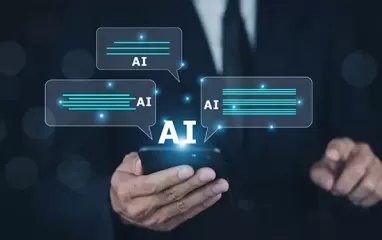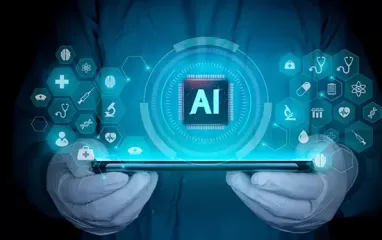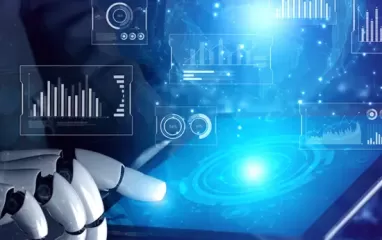Other recent blogs



Let's talk
Reach out, we'd love to hear from you!
A decade ago, expecting mobiles to play Coldplay obsequiously on an utterance of a voice command was absolutely unthinkable. The idea left us bemused with its essential strangeness and stark impossibility.
Today, it’s the same idea we’re living each day, and frankly, taking it for granted.
The rallying force behind such ultra-smart mobiles, which listen to the voice command and do exactly the task you ask for, and other *interactive* machines, is Artificial Intelligence.
An innovation of a kind, Artificial Intelligence (AI) revolutionizes machines with traits like humans. These machines become intelligent and increasingly capable of simulating functions, like Visual Perception and Speech Recognition, which are a natural prerogative of the humans as we know.
Breaking the Man-to-Machine Wall
Having met with optimism and robust technologies, Artificial Intelligence has made inroads into multiple industries, including healthcare, automotive, and retail. It can make machines capable of doing a lot more than dull jobs and shows promising signs of disrupting a myriad of other industries. Artificial Intelligence is inarguably the biggest paradigm shift for the fast-paced business world; the watershed that’s breaking the man-to-machine wall.
This post takes a tour across the three accelerators that are fuelling the pace of AI innovation, and also takes the future trends and possibilities into account that would jumpstart the adoption of AI-based technologies.
Top 3 Artificial Intelligence Accelerators
1. Next-Level Computer Architecture
Traditional microprocessors and CPUs aren’t well-equipped to accommodate the cutting-edge capabilities of Machine Learning (ML) models. Even the fastest CPUs of today don’t really cut the muster. Machine Learning needs CPUs with the best-in-class microprocessors. There’s no better an option than the Graphic Processing Units (GPUs), which are heavily in demand for their ability to accelerate the ML training process. GPUs are composed of thousands of cores that make them the best *cream of the crop* processors to boost AI-based programs and leverage execution.
Other than GPUs, Field Programmable Gate Arrays (FPGAs) are the best-touted propositions to handle high-capacity niche computing tasks, like training ML models. Public cloud vendors are strongly backing on FPGAs to develop fully-optimized and customized infrastructure for seamless AI.
Tensor Processing Unit (TPU) by Google Cloud is another big innovation that simplifies and speeds up the process of training, programming, and running deep learning models. This ASIC powers several Google’s key products, including Photos, Search, Assistant, and Gmail.
2. Easy Access to Large, Traditional Databases
Data scientists use large sets of historical data to train Machine Learning and Deep Learning models that can predict accurately. The efficiency of these models relies on the quality of the datasets they are trained on. Back in the day, the retrieval of large, traditional databases from tape cartridges and magnetic disks was tedious and time-taking. However, the advent of cloud technology and its rapid mainstreaming has changed things to full measures.
3. The Advanced Deep Neural Networks
The technological advancements in deep learning and artificial neural networks have jump-started AI innovation. The rise of Artificial Neural Networks (ANN) is resulting in the development of much precise models, and sending traditional ML models to a state of abandonment. Additionally, Convolutional Neural Networks (CNNs) brings deep learning to computer vision, which has led to an array of exciting possibilities including accurate face recognition and safe autonomous driving.
Artificial Intelligence Predictions for the Future
These AI predictions for 2019 are likely to set the ground for broader shifts in the digital ecosystem of today. Let’s us take a deep dive in.
1. Machine Learning Becoming Pervasive to Multiple Industries
A genius technology like Machine Learning cannot be restricted to a handful of industries at a time when its benefits are apparent. In the coming years, Machine Learning will be used in new and exciting ways for an array of industries and the scope of applicability goes beyond sales and marketing. The capabilities have already extended to a point where humans get predictive insights on when vehicles need repairs or when a part of the machine or equipment might run out of order. Moving ahead, the adoption of Preventive Maintenance will go mainstream.
What’s jaw-dropping is the kind of advances Machine Learning might crack in the healthcare sector. Google is already at works to use ML for predicting patients’ deaths, and the results boast a flattering figure of 95% accuracy, which is better than hospitals’ in-house warning systems. In another defining innovation, Machine Learning is further canvassed as a solution for healthcare providers, who are required to reach out to the patients in remote locations and offer treatments. If successfully modeled, such a solution will reduce the hassles of travel and paperwork.
Additionally, a research group has also established Machine Learning’s capabilities in predicting stock market highs and lows based on publicly available earning documents. The first successful result was predicting a low performing stock with 62% accuracy. Although that’s not a staggering percentage, it’s definitely worth counting on when investing in an industry as hydra-headed as the stock market.
2. Next-Generation Wearables
A team at MIT has developed an uber-advanced wearable watch, Humox Hex which is setting a ballpark for future AI-based wearable devices. The watch is extraordinary for the way it works. Besides monitoring the heart rate, it calculates muscle oxygen uptake and energy levels, so as to make real-time notifications to the users. It’s a revolutionary wearable technology of a kind that works by optimizing exercises and tracking the recovery process.
Going with the AI wind is another top-notch beauty and wellness brand, Loreal, which has invented a new wearable UV sensor to determine how much time you’re spending out in the sun and prevent excessive UV exposure. Named as UV Sense, it’s an NFC-enabled sensor you can scan with the phone to obtain UV data and works with both Android and iOS.
3. The Elevating Power of AI Assistants
Scroll back to the first line of this blog to read about the Assistants. Assistants are AI-programmed smart robots that understand natural language and complete tasks for the users. Google has *Google* Assistant, Apple has *Siri*, Amazon has *Alexa*, and Microsoft has *Cortana*. They do whatever you ask them to do via voice commands.
That said, whatever use of Assistants we know is only the tip of the iceberg. We are already surfing the internet, reading and writing emails, and paying the bills using Assistants. In the future, there will be increased adoption of Assistants for our everyday tasks. We’ll be using them in more places than just our homes. There are strong possibilities of finding Assistants in our vehicles from 2019 since companies like Kia and Hyundai have already thrown their hats in the ring.
Joining the fray are Toyota, Ford, and BMW—the behemoths which are planning on bringing Amazon Alexa to their cars by 2019.
Nvidia and Mercedes-Benz have collaborated to develop its next-gen learning AI, named MBUX, which is said to be activated by the phrase *Hey Mercedes*. AT CES 2018, the teams gave a charismatic insight introduction as to what MBUX would potentially be.
“MBUX will save and suggest your favorite music or destinations automatically as you drive; it understands the context of colloquial expressions like “can I wear my flip-flops tomorrow?” in 23 different languages; and the AI will track eye and head movement and arm gestures.”
MobileMonkey’s Facebook Chatbot Builder is another marvel to consider. It aims to amplify Facebook Advertising for marketers in order to boost sales. Since Facebook messages have an open rate of up to 80% and convert 3-5 times more than Facebook desktop ads, MobileMonkey has come up with this AI-based chatbot that lets marketers connect with their prospects straight on Facebook Messenger. As the interaction gets personalized and on-the-fly, marketers are empowered to enable a robust sales funnel and ramp up market growth considerably.
4. The Growing Convergence of AI with Augmented Reality
Augmented Reality is a different ballgame, reflecting a whole set of possibilities that merge reality with fiction. For most people, Pokemon Go has been the first-hand experience of the burgeoning Augmented Reality and the boost of Artificial Intelligence has pushed the creativity in the space to massive levels.
The convergence of AI with Augmented Reality might leverage the possibility of meeting friends in both real and virtual environments, and interact hassle-free as if sitting in the same room. AI will revolutionize education by delivering customized simulation and training to pilots, surgeons, and school students. The days aren’t far when school students will get a simulated guide while touring Alps or Amazon Jungles. This will lead to far more customized, dynamic and interactive education that books aren’t capable of.
5. Deep Interactions between Machines and Humans
Artificial Intelligence is growing out of the mundane and becoming a fully-focused strategic area for businesses. More and more companies have identified it as a key operational dimension and making contributions to add more substance to the available capabilities. Since the core motive of AI is enhancing man-to-machine interactions, efforts are underway to infuse more intelligence into the assistants, so that they can recognize more than what’s said. If achieved, this will be a major breakthrough for customer service.
Last Thoughts
Machine Learning is the new-found joy for the innovation leaders, and we are already fascinated by the advancements in the space. As we experience the skyrocketing penetration of machine learning and AI at both personal and professional fronts, there’s only more credence to the fact that these technologies will go full-throttle in the coming years, and result in many defining industry-based innovations.



